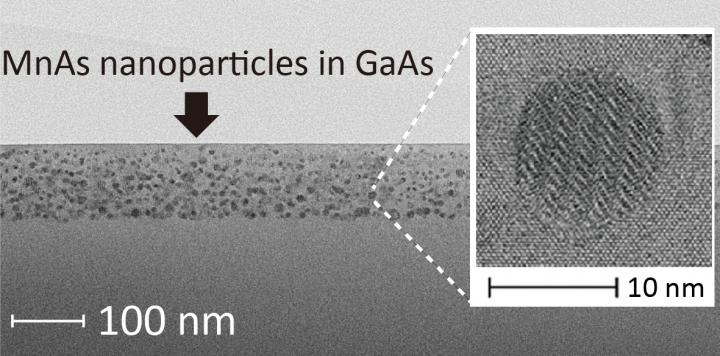Researchers demonstrate nanoparticle systems crucial for new high-speed devices

Credit: ©2019 Ohya Laboratory
For the first time researchers have demonstrated a new way to perform functions essential to future computation three orders of magnitude faster than current commercial devices. The team lead by Associate Professor Shinobu Ohya, created a nanoscale spintronic semiconductor device that can partially switch between specific magnetic states trillions of times a second (terahertz — THz), far beyond frequencies of devices at present.
There’s a high chance you’ve purchased a computer or smartphone sometime this decade. When you looked at the description you may have noticed the speed of such devices is often measured in gigahertz (GHz). At present most devices are around a few gigahertz. But progress accelerates and new ways are sought to increase the frequency and performance of our devices. To this end, UTokyo researchers from the Graduate School of Engineering and Graduate School of Frontier Sciences explore the emerging field of spintronics.
“I hope our research leads to spintronic-based logic and memory devices,” said Ohya. “Within decades people should see spintronic smartphones and data centers. We would realize incredible performance gains in areas such as artificial intelligence and beyond.”
Spintronics, aka “spin electronics,” exploits an intrinsic property of electrons called spin, — responsible for magnetic behavior — to perform functions. For example, computation relies on switchable states of a physical material as a way to transfer information. Famously, the 1 and 0 comprising binary code are represented by voltage levels in communication wires or magnetic states of a magnetic metal in a hard drive. The faster the switch between states, the greater the device’s performance. In spintronic devices, discrete spin magnetization states represent binary digits.
One way researchers create this property is to irradiate a special magnetic material with short but high-frequency pulses of terahertz radiation, similar to that of airport body scanners. The radiation flips electron spins in this material — ferromagnetic manganese arsenide (MnAs) — and thus its magnetization, in under a picosecond, three orders of magnitude quicker than transistors switch in microchips. Other researchers have attempted this before but the magnetic change in response to the pulses was only 1 percent, too small to be of practical use.
Now, however, Ohya and his team successfully demonstrated a larger magnitude change in magnetization of MnAs nanoparticles subjected to terahertz pulses. This greater response of 20 percent means it could be more useful in research and hints at possible future applications. Their trick was to take advantage of the electric component of the terahertz electromagnetic radiation rather than the magnetic component.
“Until now researchers in this area used ferromagnetic metal films to study terahertz modulation of magnetization, but these impeded the radiation’s energy,” said Ohya. “Instead we embedded our ferromagnetic nanoparticles in a semiconductor film 100 nanometers thick. This hinders the radiation far less so the terahertz electric field uniformly reaches and flips the spins, and therefore magnetization, of the nanoparticles.”
###
Journal article
Tomoaki Ishil, Hiromichi Yamakawa, Toshiki Kanaki, Tatsuya Miyamoto, Noriaki Kida, Hiroshi Okamoto, Masaaki Tanaka, and Shinobu Ohya. Large terahertz magnetization response in ferromagnetic nanoparticles. Applied Physics Letters. DOI: 10.1063/1.5088227
Grants-in-Aid for Scientific Research (Nos. JP26249039, JP18H03860, JPISHO1011, and JP16H02095). Spintronics Research Network of Japan. CREST, Japan Science and Technology Agency (Grant Nos. JPMJCR1661 and JPMJCR1777). Program for Leading Graduate Schools, Japan Society for the Promotion of Science (JSPS). JSPS Research Fellowship Program for Young Scientists for support.
Tomoaki Ishil is currently affiliated with Anritsu Corporation.
Related links
Ohya Research Group
Tanaka-Ohya Laboratory
Okamoto & Kida Laboratory
Research Contact
Associate Professor Shinobu Ohya
Department of Electrical Engineering and Information Systems, Graduate School of Engineering, The University of Tokyo, 2-11-16 Yayoi, Bunkyo-ku, Tokyo 113-8656, JAPAN
Tel: +81-3-5841-7425
Email: [email protected]
Press Contact
Mr. Rohan Mehra
Division for Strategic Public Relations, The University of Tokyo,
7-3-1 Hongo, Bunkyo-ku, Tokyo 113-8654, JAPAN
Tel: +81-3-5841-0876
Email: [email protected]
About the University of Tokyo
The University of Tokyo is Japan’s leading university and one of the world’s top research universities. The vast research output of some 6,000 researchers is published in the world’s top journals across the arts and sciences. Our vibrant student body of around 15,000 undergraduate and 15,000 graduate students includes over 2,000 international students. Find out more at https:/
Media Contact
Rohan Mehra
[email protected]
Related Journal Article
http://dx.



